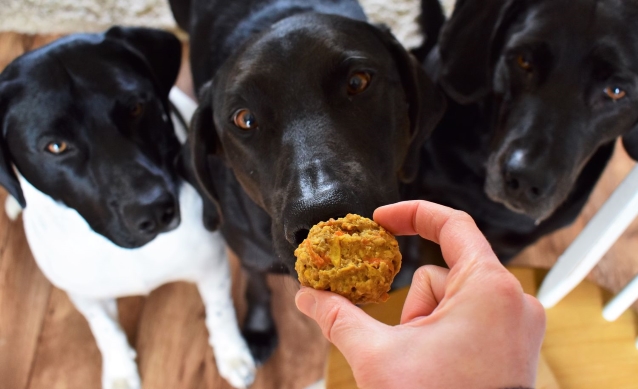Canine Nutrition: The Ultimate Guide to Healthy Dog Treats
Next to running in the park and playing, treats are probably one of your dog’s favourite things. Food treats are more than just snacks for your furry friend; they are tools for training, rewards for good behaviour, and sometimes even supplements for their health. Choosing the right ones is essential for maintaining your pet’s health and happiness. Which treats are best suited for your pup and what should you look out for?
What Are Dog Treats Made of?
Ingredients List
Just like with human food, it’s crucial to check the ingredients list when you buy treats for dogs. Opt for those made with wholesome, natural ingredients such as real meat, fruits, and vegetables. Avoid treats containing artificial preservatives, colours, and flavours, as these can be harmful to their health in the long run. Look for treats that list meat as the first ingredient, ensuring they provide quality protein.
Nutritional Value

Treats should complement your pet’s regular diet, not just serve as empty calories. Choose dog treats that offer nutritional benefits such as vitamins, minerals, and antioxidants. Some treats are formulated to support specific health needs, such as joint health or dental care. Consider treats with added health benefits, such as those containing glucosamine for joint health or omega-3 fatty acids for skin and coat health. Consider their age, size, and activity level when selecting treats with appropriate nutritional value.
Dos and Don’ts
Size and Texture
The size and texture of the treats matter, especially if you’re using them for training or as rewards. Treats should be small enough for your pooch to consume quickly without losing focus during training sessions. For smaller breeds or puppies, choose treats that are soft and easy to chew to prevent choking hazards. Larger canines may prefer crunchy treats that provide a satisfying crunch.
Allergies and Sensitivities
Be mindful of any allergies or sensitivities your pet may have to certain ingredients. Common allergens in treats for dogs include grains (wheat, corn, soy), dairy, and certain proteins. If your pup has food allergies or intolerances, opt for treats specifically labelled as hypoallergenic or grain-free. Consult with your veterinarian if you’re unsure about which ingredients to avoid.
Can You Give Your Pet Treats Every Day?
Yes, but only if they are carefully integrated into the complete diet. Treats should be given in moderation to prevent weight gain and obesity in dogs. Check the caloric content of the treats and consider it as part of your dog’s daily calorie intake. Low-calorie or calorie-controlled treats are available for pooches on restricted diets or weight management plans. Remember to adjust your pet’s meals accordingly if you’re giving them treats throughout the day.
Brand Reputation and Safety
Choose dog treats from reputable brands with a history of producing high-quality, safe products. Look for treats that undergo rigorous testing and adhere to strict quality control standards. Avoid products that have been recalled or have a history of safety concerns. Additionally, consider treats that are sourced and manufactured locally, as they may undergo fewer handling and transportation processes.
Types of Dog Treats
Biscuits and Cookies: These crunchy treats come in various shapes, sizes, and flavours. They are great for training and can help clean your pup’s teeth.
- Chewy Treats: Made from softer ingredients like meat or sweet potatoes, chewy treats are perfect for dogs who prefer softer textures.
- Dental Chews: Designed to promote dental health by reducing plaque and tartar buildup while freshening your dog’s breath.
- Freeze-Dried Treats: These treats retain most of their nutrients and flavours since they are not cooked at high temperatures. They are often made from single-ingredient proteins like chicken or beef.
- Rawhide Treats: Although popular, rawhide treats can be controversial due to potential choking hazards and digestion issues. Make sure to always monitor your pooch when giving them rawhide.
Choosing the Right Treats

As with any other pet supplies, your dog’s size, age, and dietary restrictions should be considered when selecting treats. For example, puppies may need softer treats for their developing teeth, while senior canines may benefit from treats with joint supplements. Experiment with different flavours and textures to see what your pup enjoys the most. Some breeds may prefer savoury treats, while others may have a sweet tooth.
Using Treats Effectively
Use treats as rewards during training sessions to reinforce good behaviour and encourage obedience.
Limit the number of treats given to prevent overfeeding and weight gain. Treats should make up no more than 10% of your dog’s daily caloric intake.
Use treats strategically to distract your dog during stressful situations, such as visits to the vet or grooming appointments.
Monitor your pet’s reaction to treats and discontinue any that cause digestive upset or allergic reactions.
Takeaway
Choosing the right treats involves considering your pup’s preferences, dietary needs, and health benefits. You need to understand the different types available and their ingredients, so you can make informed decisions and ensure they are not only delicious but also beneficial to their overall health and well-being. Remember to use treats in moderation and always supervise your dog when trying new treats or chew toys. With the right treats, you can strengthen your bond with your canine companion while promoting their overall well-being.



